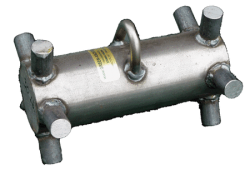 Anchors are designed to stop and hold a boat. The type of anchor that you use is very important. Not all anchors are best for all situations. It is also important to stop your boat and not drag the anchor along the bottom. This drag will destroy insect habitat and can result in a jerking stop that can cause damage or injury to the crew.
Anchors are designed to stop and hold a boat. The type of anchor that you use is very important. Not all anchors are best for all situations. It is also important to stop your boat and not drag the anchor along the bottom. This drag will destroy insect habitat and can result in a jerking stop that can cause damage or injury to the crew.
My first anchor for a canoe was a sack full of rocks. The advantage was that most watersheds had plenty of rocks on site so I did not have to carry extra weight. The netted sack could be made into any weight, easily handled and if lost, oh well. A nylon rope would hold the bag and the rocks formed to fit the bottom.
East coast anchors for the marine, sandy environs required a shovel style blade that would dig into the sandy bottom. When drifting or floating in a river, this is not what you want. This style anchor will surely stop the boat, but forget about getting it back off the bottom. It will dig in and get stuck faster than you can say “anchors aweigh”!
Pyramid style anchors are commonly used for most western drift boat applications. These lead anchors weigh 15-25 lbs. and work well. Round, lead, cannonball style anchors also work well but tend to be lighter than what is needed.
The BEST anchor that I have used weighs in at 45 lbs. It was built from a cylinder of steel with short metal posts welded to it. When dropped, the boat would stop, and the offset posts allowed me to retrieve the anchor easily. This is a heavy anchor but when needing to stop a drift boat of several hundred pounds with a trio of beefy fishermen, cooler and gear, 45 pounds does not seem like much.
A big part of a drift boat anchor is the anchor release and retrieval system. Side mounted anchor brackets help but the floor pedal system works the best. This pedal release allows the oarsman to release the anchor while keeping both hands on the oars. He can also stop the release at a point appropriate for depth and current.
Never tie a knot at the end of your anchor rope. This will prevent you from dropping the anchor in an emergency. You can always come back for the anchor. Losing an anchor is a better choice than losing a boat or life.
STOP when you need to!
Montana Grant
For more Montana Grant, hook up with him at www.montanagrantfishing.com.